Abstract
This study presents a method for inhibiting ethylene production during the room-temperature storage of plum fruits, using gaseous ozone (O3). The proposed storage strategy involves the cyclic ozone treatment of fruits every 24 h with specified O3 doses. Throughout the storage period, cyclic analyses of the atmosphere composition in storage chambers were conducted, measuring ethylene and carbon dioxide levels. Several parameters describing changes in fruit quality and biochemical transformations were systematically monitored until the end of the storage process. The results clearly indicate that fruits subjected to cyclic ozone treatment with the highest O3 doses during storage exhibit the slowest ripening rate. This reduced ripening rate is primarily attributed to the downregulation of S-adenosylmethionine synthetase expression, leading to a lower ethylene concentration in the storage chambers. Other obtained results concerning soluble solid content, titratable acidity, total polyphenols, anthocyanins, and vitamin C content confirm the observations regarding the impact of ozone treatment in slowing down the fruit ripening process. The best outcomes were achieved by applying a cyclic ozone process with a 100 ppm dose for 30 min.
1. Introduction
Plums (Prunus domestica) are a significant component of the global fruit market, with a production history dating back thousands of years [1]. Prunus domestica is one of the oldest fruit tree species cultivated by humans. In 2021, global plum fruit production amounted to approximately 13.6 million tons, with China, India, Serbia, Romania, and Russia being the leading producers. In general, plum production is even greater, considering other species such as Prunus salicina.
Plum fruits belong to the category of climacteric fruits, which means they can ripen after harvesting. The ripening process of these fruits is associated with the biosynthesis of ethylene, which acts as the primary regulator of this process. As plums ripen, the concentration of ethylene in their immediate vicinity increases, accelerating physiological processes and ultimately leading to changes in fruit color, texture, and taste, resulting in aging and spoilage [2].
To maintain the freshness and quality of plums after harvesting, proper storage conditions are essential. The most critical factor influencing the shelf life of plums is temperature. The optimal storage temperature for plums ranges from 0 to 2 °C, which helps slow down the ripening process and preserves the fruit’s freshness for an extended period [3]. Air humidity also plays a significant role in the storage of these fruits and should be maintained at around 90–95%. This level of humidity prevents fruit water loss, which, in turn, helps maintain turgor and the quality of the stored fruits. In addition to selecting appropriate temperature and humidity, various techniques are employed in fruit storage to enable producers and distributors to maintain the fruits in the best possible condition throughout the supply chain [4].
One of the popular methods used in fruit storage is the modification of the atmosphere, including controlled atmosphere (CA) and modified atmosphere (MA). Controlled atmosphere storage is an advanced technique that aims to preserve the freshness and quality of fruits for an extended period by controlling the atmospheric composition within the storage room. CA is particularly effective for climacteric fruits that produce ethylene, which accelerates their ripening process. The technology involves maintaining a constant level of oxygen (O2) and carbon dioxide (CO2) in the storage room. Typical CA parameters include O2 concentrations of 1–5% and CO2 concentrations of 1–10% [5]. On the other hand, the modified atmosphere (MA) method allows for adjusting the atmosphere within the storage chamber or fruit packaging to the specific requirements of a particular fruit variety, significantly delaying the ripening process and preserving the flavor and texture of the fruits. The main atmospheric components monitored and controlled include O2, CO2, humidity, and, in some cases, nitrogen or ethylene (C2H4) [6]. It should be noted that modified atmosphere (MA) with horticultural products is typically described as a mostly passive process within packages, while controlled atmosphere (CA) employs constant and often precise dynamic adjustment atmospheres within the entire cold storage room. The MA package atmosphere can be purged initially with an optimum atmosphere; in other instances, the modified atmosphere is commodity generated and maintained inside packages by product respiration alone. Both MA techniques typically employ semipermeable barrier liner films to enable a retention of the proper atmosphere.
Another way to extend the shelf life of fruits in the supply chain is through the ozonation process [7,8]. In recent years, gaseous ozone (O3) has gained importance as an effective factor in prolonging the shelf life of fruits in the food industry. O3 is an allotropic form of oxygen with the ability to disinfect and maintain the freshness of plant-based materials by reducing microbiological contamination and enzymatic processes [7,8]. However, most of the literature focuses on the impact of a one-time ozone treatment of plant materials immediately after harvesting on their quality and shelf life. The application of an ozonation process to extend the shelf life of fresh commodities is the subject of numerous studies. Moreover, this technology is of significant commercial interest, especially since ozone leaves no residues on the products. The effectiveness of the ozonation process as a shelf-life extension method for raw materials is mainly determined by the reduction in microbiological load, the modification of biochemical processes in stored fresh commodities, the regulation of metabolic processes, and through the conversion of selected gas factors susceptible to the oxidation process (especially ethylene) [7,8,9].
In this study, the influence of a cyclic ozone treatment process on plum fruits during storage was determined to inhibit ethylene production and assess storage quality. The research hypothesis was that the cyclic application of gaseous ozone in the storage chamber contributes to limiting ethylene biosynthesis in plum fruits, thereby extending their shelf life.
2. Materials and Methods
2.1. Research Material
The research material consisted of ‘Cacanska Lepotica’ plum fruits harvested at the mature stage. The fruits were free from mechanical damage and signs of pest infestation. Additionally, the fruits displayed a dark purple-blueish hue, characteristic of this cultivar. The soluble solid content in the fruit samples selected for storage experiments averaged 10.15 g 100 g f.m.−1 in weight, and the titratable acidity was 2.57 g 100 g f.m.−1 in the fruits.
2.2. Ozonation Procedure for Fruit during the Supply Chain Storage Stage
Samples of ‘Cacanska Lepotica’ plum fruits were each placed in storage chambers where the temperature during the experiment was maintained at approximately 20 °C. A single experimental trial (n = 9) involved 5 kg of fruit. The average fruit mass was ±30 g. Fruits in lattice-designed individual containers dedicated to fruit storage were placed in storage chambers. One storage chamber constituted one repetition. Fruit samples from each experimental variant occupied 80% of the storage chamber volume. Subsequently, a cyclic ozone treatment of plum fruits was carried out using the Korona Lab ‘Zdrowa żywność’ ozone generator (KoronaLab, Piotrków Trybunalski, Poland) dedicated to food applications. The concentration of O3 in the storage chambers during the process was monitored using a 2B Technologies 106M detector (2B Technologies, Broomfield, CO, USA) with a measurement range of 0 to 1000 ppm.
The plum fruits, at the storage stage within the supply chain, were subjected to cyclic ozone treatment with gaseous O3 at concentrations of 10 and 100 ppm. The ozone treatment for the selected O3 concentrations was conducted for 5, 15, and 30 min each. Ozone treatment was performed cyclically, once every 24 h, for a duration of 5 days. Control groups consisted of plum fruit samples that did not undergo the ozone treatment process. The ozone treatment process was repeated three times for each experimental variant.
2.3. Measurement of Storage Gas Concentrations
The measurement of O2 (%), CO2 (%), and C2H4 (ppm) concentrations in the storage chambers of plum fruits, depending on the parameters of the cyclic ozone treatment, was conducted using the F-950 gas analyzer (STEP Systems GmbH, Nürnberg, Germany). The airflow from the storage chambers during measurements was set at 80 mL min−1. Gas concentration measurements were taken every 24 h, just before each ozone treatment process, and 30 min after the completion of the process. These measurements were repeated 12 times for each experimental variant.
2.4. Determination of Bioactive Compound Content
On the last day of the storage experiment, the impact of the applied ozone on the content of bioactive compounds in plum fruits was determined. The total polyphenol content was determined using the Folin–Ciocalteu method, following the procedure described in Matłok et al., 2019 [10]. The quantitative results were presented as the equivalent of gallic acid content per 100 g of fresh plum fruits [mg GAE 100 g f.m.−1]. The total anthocyanin content in the fruits was determined using the spectrophotometric method of Francis-Fulka, as described in Piechowiak et al., 2019 [11]. The results were expressed as cyanidin-3-glucoside equivalents per 100 g of fresh fruit weight. The antioxidant potential of the tested material was assessed using the ABTS method [10], and the results were expressed as trolox equivalents per 100 g of fruit. The vitamin C content in plum fruits was determined using the method described in Matłok et al., 2022 [12]. Each determination of the content of bioactive compounds in plum fruits was carried out in triplicate for each experimental variant.
2.5. Determination of Soluble Solid Content and Titratable Acidity
To determine the soluble solid content and titratable acidity, 10 g of diced tissue (from pitted fruits) was homogenized with 10 mL of pre-boiled and cooled distilled water. Subsequently, the homogenate was centrifuged at 7500× g for 30 min and reserved for analysis. The titratable acidity of the fruits was determined through potentiometric titration of the extract using 0.1 M NaOH, and the results were expressed as citric acid equivalents (could be recalculated to malic acid) per 100 g of fruit. The soluble solid content in the extract was assessed refractometrically using an Abbego refractometer (PZO, Warszawa, Poland), following the procedure described in Piechowiak et al., 2022 [13], and the obtained results were expressed as grams of soluble solid content per 100 g of fruit.
2.6. Determination of the Activity of SAMS, MnSOD, and CAT Enzymes
Before proceeding with the actual immunoblotting, protein from plum tissue was isolated by homogenizing the tissue in a lysis buffer containing 1% SDS, 0.1 M Tris-HCl (pH 6.8), 2 mM EDTA, 20 mM DTT, and a mixture of protease inhibitors. After centrifugation, the protein was precipitated from the supernatant by mixing the supernatant in a 1:1 ratio with 20% TCA (in acetone). The protein pellet was then centrifuged, washed twice with 80% acetone, dried to remove any remaining acetone, and re-suspended in 100 mM Tris-HCl (pH 8.8) [14].
The SDS-PAGE and immunoblotting procedures are described in more detail in the work by Skóra et al. [15]. In summary, in the first step, the proteins were separated on a 7.5% polyacrylamide gel, and then the proteins were transferred to an Immobilon®-P PVDF membrane (Sigma-Aldrich, St. Louis, MO, USA) by electroblotting overnight at 35 V in 4 °C. Subsequently, non-specific sites on the membrane were blocked using 1% BSA in TBST buffer, followed by incubation (overnight at 4 °C) in a solution of rabbit anti-SAM antibodies (Agrisera/AS16 3148, dilution 1:1000), anti-MnSOD (Agrisera/AS09 524, dilution 1:1000), anti-CAT (Agrisera/AS09 501, dilution 1:1000), and anti-Actin (Agrisera/AS10 833, dilution 1:1000). After three washes with TBST buffer, the membranes were incubated (1 h) with secondary antibodies (mouse anti-rabbit) conjugated with horseradish peroxidase (Agrisera/AS13 2640, dilution 1:20,000). After another three washes, the membranes were immersed in ECL Western Blotting Reagents (Sigma-Aldrich) and detected using a chemiluminescence reader. The protein expression was normalized to actin and expressed relative to the control sample.
2.7. Determination of Adenosine-5′-Triphosphate (ATP) Level
The sample for determining the ATP level in plums was prepared by homogenizing frozen tissue in 0.3 M HClO4, centrifuging the supernatant, neutralizing it with 1 M KOH, and then centrifuging it again to remove potassium perchlorate, following the procedure described in Zhou et al. 2014 [16]. The ATP level in the supernatants was analyzed using a commercial assay from Sigma-Aldrich (catalog number MAK190). This assay is based on the phosphorylation of glycerol in the presence of ATP and the fluorometric measurement of the resulting product at an excitation wavelength of 535 nm and an emission wavelength of 587 nm.
2.8. Statistical Analysis
The obtained research results were subjected to statistical analysis using the STATISTICA 13.1 software (TIBCO Software Inc., Hillview Avenue, Palo Alto, CA, USA). A one-way analysis of variance (ANOVA) was performed with a significance level of α = 0.05.
3. Results and Discussion
3.1. Changes in Gas Concentrations in Storage Chambers
Ethylene is a natural plant hormone that accelerates the ripening of climacteric fruits and vegetables. High concentrations of ethylene in storage chambers can lead to the faster aging and spoilage of stored products. Regulating the concentration of this gas and maintaining lower levels in storage chambers can contribute to extending the shelf life and freshness of stored fresh commodities [17,18].
During the experiment, measurements of ethylene concentration in the storage chambers were taken cyclically every 24 h, both before and 30 min after the ozone treatment (when ozone disappears) (Figure 1). It was observed that the C2H4 concentration in the chambers significantly depended on the applied dose of gaseous O3 and the measurement time (day of the experiment). The best reduction effects in C2H4 concentration in the storage chambers were observed in the variant where the highest dose of gaseous O3 (100 ppm for 30 min) was applied. A cyclic (every 24 h) 30 min exposure of plum fruits to gaseous O3 at a concentration of 100 ppm resulted in a significant reduction in C2H4 in the storage chambers, which, on the fifth day of the storage experiment, was on average lower by 93.4% (before the ozone treatment) and 97.3% (30 min after the ozone treatment) compared to the concentration of this gas in the control chambers (without the use of ozone treatment as a factor to extend the shelf life of fruits). Ozone underwent complete decomposition to oxygen within 30 min. This did not affect the registered oxygen concentration, as ozone was generated from the air. It should be noted that, during the experiment, the oxygen level in the chamber remained constant (~19.7%), despite evident signs of fruit metabolism (recorded CO2 level). This was due to the frequent exchange of the chamber atmosphere induced by the ozone process.
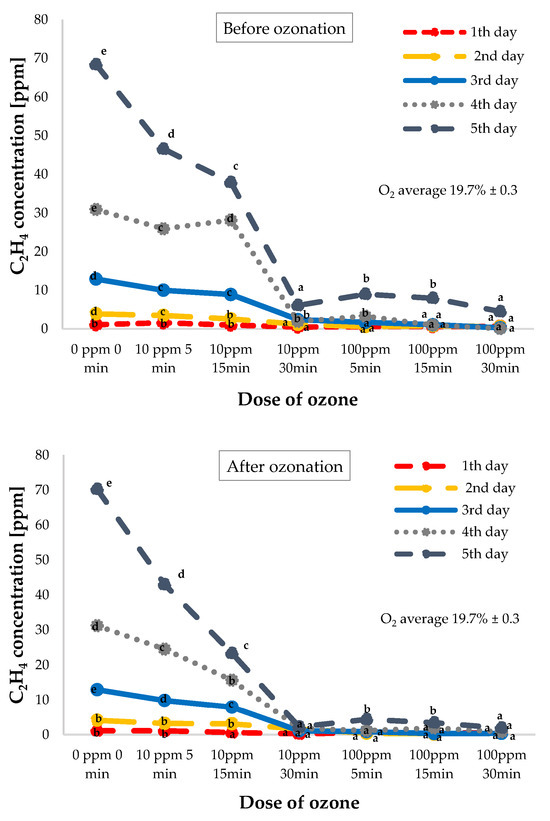
Figure 1.
The course of changes in C2H4 concentration [ppm] in the storage chambers on different days of the experiment, both immediately before and after the ozone treatment, depending on its parameters. NOTE: Differences in the results between the dose of ozone; significant differences at the p < 0.05 level; different lowercase letters indicate significant differences between variants (n = 9).
3.2. Activity of SAMS, MnSOD, and CAT Enzymes
The significantly lower concentration of C2H4 in the storage chambers, where plum fruits were subjected to a cyclic application of gaseous ozone, was most likely due to the reduced expression of S-adenosulmethionine synthetase (SAMS). On the last day of the storage experiment, the plum fruits were analyzed to determine the activity of selected enzymes, including the expression of SAMS. Ozone-treated plum fruits showed a significantly lower expression of S-adenosulmethionine synthetase (SAMS), and its level depended on the applied dose of O3 (Figure 2). The lowest expression of SAMS was observed in plum fruits subjected to cyclic ozone treatment at a concentration of 100 ppm for 30 min. The expression of SAMS for this fruit sample was 85.9% lower than the expression of SAMS in the control sample (fruits untreated with O3 as a factor to extend their shelf life). The reduced expression of S-adenosulmethionine synthetase (SAMS) in ozone-treated fruits most likely resulted in the reduced production of S-adenosyl-L-methionine (SAM), a precursor of C2H4 in reactions catalyzed by ACC synthase (1-Aminocyclopropane-1-carboxylate synthase) and ACC oxidase (Aminocyclopropanecarboxylate oxidase). This led to a lower release of C2H4 by ozone-treated fruits (Figure 1). The role of SAM in the biosynthesis of the plant hormone C2H4 has also been confirmed by other researchers [19]. Roje et al. [20] found that SAM is synthesized from methionine and ATP, catalyzed by SAM synthetase (SAMS), and affects a range of biochemical reactions in plants, including the biosynthesis of polyamines and C2H4, as well as transmethylation reactions.
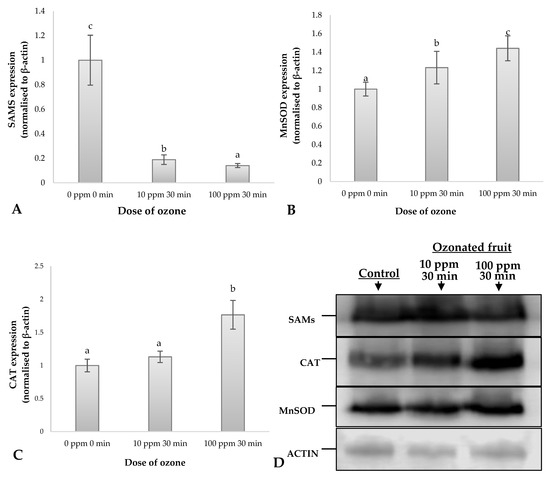
Figure 2.
Expression of S-adenosulmethionine synthetase (SAMS) (A), MnSOD (B), and CAT (C) in plum fruits on the 5th day of storage, depending on the parameters of the cyclic ozone treatment. Photos of blots after chemiluminescent detection (D). NOTE: Differences in the results between the dose of ozone; significant differences at the p < 0.05 level; different lowercase letters indicate significant differences between variants (n = 9).
The lower expression, and probably activity, of S-adenosulmethionine synthetase (SAMS) in the case of plum fruits subjected to cyclical ozonation during storage may have been caused by a lower amount of adenosine-5′-triphosphate (ATP) in the fruits (Figure 3), which likely resulted from a reduction in their respiration rate (Figure 4). Fruits stored under control conditions (not subjected to ozonation) on the 5th day of the storage experiment contained approximately 60.0% more ATP than fruits subjected to cyclical ozonation with a dose of 10 ppm for 30 min and 192.7% more than fruits subjected to cyclical ozonation with a dose of 100 ppm for 30 min. The observed decrease in ATP content in ozonated fruits indicates a significant impact of ozonation on the intensity of all metabolic processes that require ATP for biosynthesis or biotransformation. The main factor affecting the intensity of biosynthesis or biotransformation processes in closed chambers may be the level of carbon dioxide (CO2), the changes in which were induced by the respiration rate of the fruits (Figure 4). Changes in the concentration of this gas were observed during storage, but the analysis of the results obtained indicates that the duration of ozonation is the main factor determining the amount of generated CO2. It was shown that 30 min ozonation treatments, regardless of the O3 concentration, similarly inhibited the release of CO2, which indicates a decreased metabolism intensity (Figure 3). However, the best effects on the 5th day of storage were observed for the sample of plum fruits subjected to cyclical ozonation with a dose of 100 ppm for 30 min, which was also confirmed by the ATP content in the fruits.
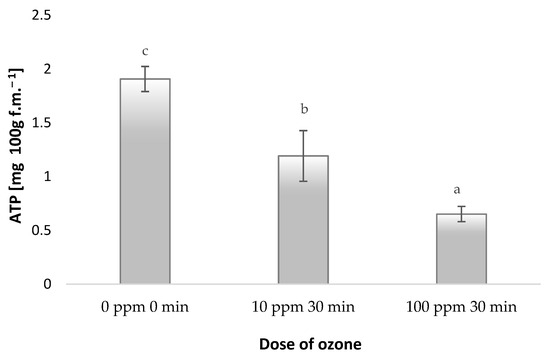
Figure 3.
ATP content in plum fruits on the 5th day of storage depending on the parameters of the cyclical ozonation process. NOTE: Differences in the results between the dose of ozone; significant differences at the p < 0.05 level; different lowercase letters indicate significant differences between variants (n = 9).
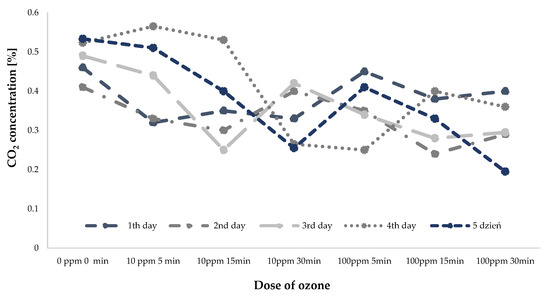
Figure 4.
The course of changes in the concentration of CO2 [%] in the storage chambers on specific days of the experiment, immediately after the ozonation process, depending on its parameters.
It should be noted that a biochemical mechanism may be supported by the direct degradation of ethylene during the ozonation process, but the cyclic nature (maximum 30 min/24 h) of this process suggests that it is a short-term action. This is confirmed by the registration of lower ozone concentrations after the ozonation process. Ethylene undergoes ozonolysis, decomposing into gaseous products without contaminating the fruits.
3.3. Biochemical Indicators of Plum Fruit Ripeness
Indicators that determine the degree of ripeness of fruits and vegetables include their qualitative and sensory parameters, which include the content of extract as well as their acidity. Fruits that are more mature are characterized by higher nutritional value (higher content of bioactive compounds and vitamins), a more intense color, and changes in texture [21,22].
On the last day of the storage experiment, the plum fruits were subjected to biochemical analyses to confirm the impact of the ozone treatment on extending their shelf life in the supply chain. Figure 5 shows the content of selected compounds in plum fruits depending on the conditions used during storage (with ozone treatment and without (control)). The content of substances that shape the degree of fruit ripeness varied depending on the conditions applied. Plum fruits subjected to cyclic ozonation during storage had higher acidity and lower levels of selected bioactive compounds. However, this content varied depending on the dose of gaseous O3 used. The best results were obtained when using an O3 concentration of 100 ppm and a treatment time of 30 min. Plum fruits subjected to cyclic treatment with this O3 dose exhibited the highest acidity (Figure 5B). This acidity was on average 19.6% lower compared to the control (non-ozone-treated fruits), which simultaneously confirms a lower degree of fruit ripeness and, therefore, extended shelf life in the supply chain.
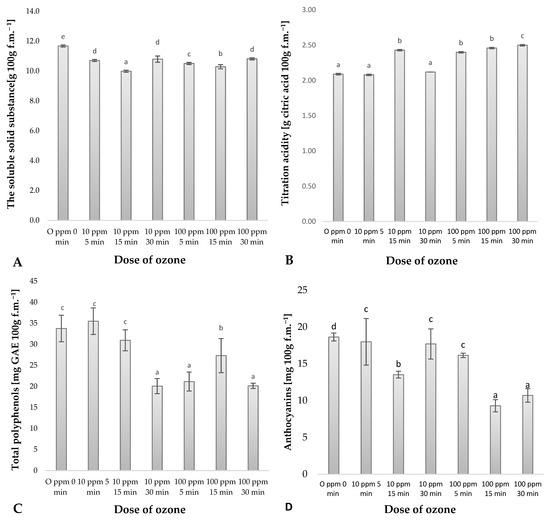

Figure 5.
Biochemical parameters of fruits on the 5th day of the experiment depending on the parameters of the cyclic ozone process. NOTE: Differences in the results between the dose of ozone; significant differences at the p < 0.05 level; different lowercase letters indicate significant differences between variants (n = 9). (A)-The soluble solid substance, (B)-Titration acidity, (C)-Total polyphenols, (D)-Anthocyanin’s, (E)-Antioxidant activity, (F)-Vitamin C content.
During the ripening of fruits, polysaccharides are transformed into simple sugars, which are measured by the content of soluble solids. The analysis of the obtained results clearly indicates that the content of soluble solids depended significantly on the ozone treatment conditions. The lowest content of soluble solids was noted for fruits subjected to cyclic ozonation with a dose of 10 ppm for 15 min (Figure 5A). However, in the case of longer ozone treatment times, these results also significantly differed from the control sample. As indicated by [23], many factors affect the content of total soluble solids (TSS) in stored plant raw materials. Conditions that positively influence the storage process significantly contribute to inhibiting the generation of this factor (TSS) in fresh commodities. During the prolonged storage of climacteric fruits collected at the stage of bulk ripeness (non-consumable), biotransformation also occurs, generating bioactive compounds, which can serve as markers of ripeness in some cases. The highest levels of low-molecular-weight antioxidants, such as total polyphenols, anthocyanins, and vitamin C, were recorded for the control sample, which may indicate the fastest ripening process after harvest (at the storage stage) (Figure 5C–F). Similar results were obtained for samples subjected to cyclic ozonation during storage with the lowest ozone doses. The other ozone doses used for the cyclic ozonation process of plum fruits during storage largely generated these substances, indicating a slowed post-harvest ripening process.
4. Conclusions
The proposed storage strategy involving cyclic ozone treatment of plum fruits in cold storage rooms significantly influenced the ripening rate of the stored fruits. It was demonstrated that the action of O3 is multifaceted, with the dominant mechanism being the inhibition of SAMs expression, which breaks down into SAM, a precursor to ethylene. The biochemical measurements of enzymatic activity align with the measurements of ethylene concentrations in the storage chambers. The biochemical mechanism may be supported by the direct degradation of ethylene during the ozone process, but the cyclic nature (maximum 30 min/24 h) of this process suggests that it is a short-term action. Other markers for assessing the degree of fruit ripeness confirm the observations of enzymatic activity. Notably, the observed reduction in ATP concentrations, which decrease with the ozone dose, was supported by the measurement of other biochemical markers, such as the content of soluble solids, titratable acidity, the content of total polyphenols, anthocyanins, and vitamin C. The best results in extending the shelf life of plum fruits by inhibiting ethylene generation were achieved with the cyclic ozone process using a dose of 100 ppm for 30 min, analyzing the majority of parameters. However, in some cases for selected markers, different conditions induced more profound changes. This method appears to be uncomplicated and cost-effective, indicating its potential as an effective method for extending the shelf life of plum fruits during storage. Future research will be expanded to include a comprehensive analysis of surface pitting, pitting at stomata, color changes, internal browning, fruit firmness measurements, sensory panel data (especially off-flavor detection), moisture loss, and ethanol and acetaldehyde contents to understand the qualitative changes in fruits during storage under the proposed conditions.
Author Contributions
Conceptualization, methodology, visualization, investigation, and writing—original draft preparation, N.M.; investigation, T.P., C.P. and A.K.; investigation and writing—original draft preparation, M.B. All authors have read and agreed to the published version of the manuscript.
Funding
The project was financed by the program of the Minister of Education and Science named “Regional Initiative of Excellence” in the years 2019–2023, project number 026/RID/2018/19, the amount of financing PLN 9 542 500.00.
Institutional Review Board Statement
Not applicable.
Data Availability Statement
Data are contained within the article.
Conflicts of Interest
The authors declare no conflict of interest.
References
- Ezinne, O.; Charlton, K.E. A Systematic Review on the Health Effects of Plums (Prunus domestica and Prunus salicina). Phytother. Res. 2016, 30, 701–731. [Google Scholar] [CrossRef]
- Plich, H. Storage performance in plums (Prunus domestica L.) Treated with ethephon before harvest and with 1-MCP after harvest. Acta Hortic. 2008, 768, 135–142. [Google Scholar] [CrossRef]
- Panahirad, S.; Naghshiband-Hassani, R.; Ghanbarzadeh, B.; Zaare-Nahandi, F.; Mahna, N. Shelf Life Quality of Plum Fruits (Prunus domestica L.) Improves with Carboxymethylcellulose-based Edible Coating. HortSci. Horts 2019, 54, 505–510. [Google Scholar] [CrossRef]
- Vangdal, E.; Flatland, S.; Lunde Knutsen, I.; Larsen, H. Factors affecting storability and shelf life in plums (Prunus domestica L.). Acta Hortic. 2012, 968, 197–203. [Google Scholar] [CrossRef]
- Dilley, D.R. Controlled atmosphere storage—Chronology and technology. Acta Hortic. 2010, 857, 493–502. [Google Scholar] [CrossRef]
- Iannetta, P.P.M.; Laarhoven, L.; Medina-Escobar, N.; James, E.K.; McManus, M.T.; Davies, H.V.; Harren, F.J.M. Ethylene and carbon dioxide production by developing strawberries show a correlative pattern that is indicative of ripening climacteric fruit. Physiol. Plant. 2006, 127, 247–259. [Google Scholar] [CrossRef]
- Natha, A.; Mukhimb, K.; Swerb, T.; Debashis, D.; Vermaa, N.; Dekab, B.C.; Gangwar, B.M. A Review on Application of Ozone in the Food Processing and Packaging. J. Food Prod. Dev. Packag. 2014, 1, 7–21. [Google Scholar] [CrossRef]
- Rivas-Arancibia, S.; Hernández-Orozco, E.; Rodríguez-Martínez, E.; Valdés-Fuentes, M.; Cornejo-Trejo, V.; Pérez-Pacheco, N.; Dorado-Martínez, C.; Zequeida-Carmona, D.; Espinosa-Caleti, I. Ozone Pollution, Oxidative Stress, Regulatory T Cells and Antioxidants. Antioxidants 2022, 11, 1553. [Google Scholar] [CrossRef]
- Botondi, R.; Barone, M.; Grasso, C. A Review into the Effectiveness of Ozone Technology for Improving the Safety and Preserving the Quality of Fresh-Cut Fruits and Vegetables. Foods 2021, 10, 748. [Google Scholar] [CrossRef]
- Matłok, N.; Gorzelany, J.; Stępień, A.E.; Figiel, A.; Balawejder, M. Effect of Fertilization in Selected Phytometric Features and Contents of Bioactive Compounds in Dry Matter of Two Varieties of Basil (Ocimum basilicum L.). Sustainability 2019, 11, 6590. [Google Scholar] [CrossRef]
- Piechowiak, T.; Antos, P.; Kosowski, P.; Skrobacz, K.; Józefczyk, R.; Balawejder, M. Impact of ozonation process on the microbiological and antioxidant status of raspberry (Rubus ideaeus L.) fruit during storage at room temperature. Agric. Food Sci. 2019, 28, 35–44. [Google Scholar] [CrossRef]
- Matłok, N.; Piechowiak, T.; Zardzewiały, M.; Balawejder, M. Effects of Post-Harvest Ozone Treatment on Some Molecular Stability Markers of Amelanchier alnifolia Nutt. Fruit during Cold Storage. Int. J. Mol. Sci. 2022, 23, 11152. [Google Scholar] [CrossRef]
- Piechowiak, T.; Grzelak-Błaszczyk, K.; Sójka, M.; Skóra, B.; Balawejder, M. Quality and antioxidant activity of highbush blueberry fruit coated with starch-based and gelatine-based film enriched with cinnamon oil. Food Control 2022, 138, 109015. [Google Scholar] [CrossRef]
- Niu, L.; Zhang, H.; Wu, Z.; Wang, Y.; Liu, H.; Wu, X.; Wang, W. Modified TCA/acetone precipitation of plant proteins for proteomic analysis. PLoS ONE 2018, 13, e0202238. [Google Scholar] [CrossRef] [PubMed]
- Skóra, B.; Matuszewska, P.; Masicz, M.; Sikora, K.; Słomczewska, M.; Sołtysek, M.; Szychowski, K.A. Crosstalk between the aryl hydrocarbon receptor (AhR) and the peroxisome proliferator-activated receptor gamma (PPARγ) as a key factor in the metabolism of silver nanoparticles in neuroblastoma (SH-SY5Y) cells in vitro. Toxicol. Appl. Pharmacol. 2023, 458, 116339. [Google Scholar] [CrossRef] [PubMed]
- Zhou, Q.; Zhang, C.; Cheng, S.; Wei, B.; Liu, X.; Ji, S. Changes in energy metabolism accompanying pitting in blueberries stored at low temperature. Food Chem. 2014, 164, 493–501. [Google Scholar] [CrossRef] [PubMed]
- Tripathi, K.; Pandey, S.; Malik, M.; Kaul, T. Fruit Ripening of Climacteric and Nonclimacteric Fruit. J. Environ. Appl. Biores. 2016, 4, 27–34. [Google Scholar]
- An, J.; Paull, R.E. Storage Temperature and Ethylene Influence on Ripening of Papaya Fruit. J. Am. Soc. Hortic. Sci. Jashs 1990, 115, 949–953. [Google Scholar] [CrossRef]
- De Poel, B.V.; Bulens, I.; Oppermann, Y.; Hertog, M.L.A.T.M.; Nicolai, B.M.; Sauter, M.; Geeraerd, A.H. S-adenosyl-l-methionine usage during climacteric ripening of tomato in relation to ethylene and polyamine biosynthesis and transmethylation capacity. Physiol. Plant. 2012, 148, 176–188. [Google Scholar] [CrossRef]
- Roje, S. S-Adenosyl-L-methionine: Beyond the universal methyl group donor. Phytochemistry 2006, 67, 1686–1698. [Google Scholar] [CrossRef]
- Zhang, H.; Li, K.; Zhang, X.; Dong, C.; Ji, H.; Ke, R.; Ban, Z.; Hu, Y.; Lin, S.; Chen, C. Effects of ozone treatment on the antioxidant capacity of postharvest strawberry. RSC Adv. 2020, 63, 38142–38157. [Google Scholar] [CrossRef]
- Cozzolino, R.; Pace, B.; Palumbo, M.; Laurino, C.; Picariello, G.; Siano, F.; De Giulio, B.; Pelosi, S.; Cefola, M. Profiles of Volatile and Phenolic Compounds as Markers of Ripening Stage in Candonga Strawberries. Foods 2021, 10, 3102. [Google Scholar] [CrossRef]
- Tangpao, T.; Phuangsaujai, N.; Kittiwachana, S.; George, D.R.; Krutmuang, P.; Chuttong, B.; Sommano, S.R. Evaluation of Markers Associated with Physiological and Biochemical Traits during Storage of ‘Nam Dok Mai Si Thong’ Mango Fruits. Agriculture 2022, 12, 1407. [Google Scholar] [CrossRef]
Disclaimer/Publisher’s Note: The statements, opinions and data contained in all publications are solely those of the individual author(s) and contributor(s) and not of MDPI and/or the editor(s). MDPI and/or the editor(s) disclaim responsibility for any injury to people or property resulting from any ideas, methods, instructions or products referred to in the content. |
© 2023 by the authors. Licensee MDPI, Basel, Switzerland. This article is an open access article distributed under the terms and conditions of the Creative Commons Attribution (CC BY) license (https://creativecommons.org/licenses/by/4.0/).